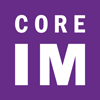Core IM
Despite knowledge regarding the lack of specificity of ANA positivity, there remain gaps in understanding and practice patterns related to ANA referrals and interpreting ANA positivity. Given rates of ANA positivity up to 15-20% in the otherwise healthy population, recognizing symptoms and laboratory findings that raise concern for autoimmune disease and warrant ANA testing is critical to understand. This episode will explore the significance of a positive ANA, including how to interpret ANA titers and patterns. The Core IM team will review signs, symptoms, laboratory testing and physical exam findings that are concerning for autoimmune disease for which an ANA should be sent. Finally, the episode will review conditions associated with a positive ANA that are not rheumatologic including infections, malignancies and other non-rheumatic autoimmune diseases. You’re invited to join the team for ANA (Antinuclear Antibody) Test: 5 Pearls Segment.
First, listen to the podcast. After listening, ACP members can take the CME/MOC quiz for free.
CME/MOC:
Up to 0.5
AMA PRA Category 1 Credits ™ and MOC Points
Expires October 06, 2025
active
Cost:
Free to Members
Format:
Podcasts and Audio Content
Product:
Core IM
Welcome to Core IM, a virtual medical community! Core IM strives to empower its colleagues of all levels and backgrounds with clinically applicable information as well as inspire curiosity and critical thinking. Core IM promotes its mission through podcasts and other multimodal dialogues. ACP has teamed up with Core IM to offer continuing medical education, available exclusively to ACP members by completing the CME/MOC quiz.

Pearl 1: An ANA does not mean a patient has an autoimmune disease
- First, what exactly is an ANA?
- Autoantibodies to antigens in the nucleus
- The thought is in autoimmune diseases there is dysregulated apoptosis. When the cells breaks down, the contents inside the nucleus come out of the cell. The dendritic cells can present the nuclear antigens to T cells, which then activate B-cells to create antibodies.
- Can be obtained by 2 different tests
- IFA (indirect immunofluorescence assay)
- ELISA
- Autoantibodies to antigens in the nucleus
- What are some of the challenges of interpreting a +ANA?
- Does the titer matter? Yes!
- The likelihood of disease increases with increasing antibody titer (level).
- One study found:
- 1:40 – up to 33% of the healthy pop
- 1:80 – 10-15% of healthy pop
- 1:160 – 5% of healthy pop
- 1:320 – 3% of healthy pop
- Study showed that 1% of healthy individuals had titers ≥ 1:2560.
- For example, a titer of 1:80 has a LR of 0.5 versus 1:640 titer has LR of 19
- The pattern of the ANA is usually non-specific
- Except for if the pattern centromere in the appropriate clinical setting (Raynaud’s phenomenon, skin changes, esophageal dysmotility) would suggest scleroderma
- Nuclear dense fine speckled was exclusively seen in healthy individuals in some studies, though other data suggest this can be seen in patients with autoimmune diseases as well
- “Monospecific DFS70 may help exclude CTD”
- Keep in mind, ANAs can be positive long before any rheumatological symptoms.
- In one study of military recruits that were ultimately diagnosed with lupus, the earliest antibodies before any clinical symptoms were ANA, dsDNA Anti-Ro and Anti-La.
- They were found between 3 – 9 years before diagnosis. Then, closer to diagnosis of lupus, anti-Smith and AntidsDNA antibodies were found.
- Experts like Dr. Jonas still counsels patients that the likelihood that developing rheumatological disease with a sole positive ANA is low and counsels regarding symptoms that may need further workup.
Pearl 2: Check an ANA only if suspicion for autoimmune disease, not non-specific pain or fatigue vs. What patient histories should you not get an ANA for and which aspects of the history would raise suspicion for autoimmunity?
- Do not order for fatigue, diffuse joint pain alone (non-inflammatory history), or other mild nonspecific symptoms that have been ongoing for years.
- If an ANA is ordered, there is a 1 in 5 chance in a woman that the ANA will be positive.
- Ask about:
- Photosensitivity
- “Do you feel sick when you are in the sun?”
- Dry eyes or dry mouth
- Oral ulcers (often painless and on the hard palate = more unique to SLE)
- History of clots or pregnancy losses
- Raynaud’s
- Photosensitivity
- Symptoms with highest odds ratio for SLE compared to fibromyalgia:
- Raynaud’s, rash, fever, easing bruising, hair loss
- Examples of more “clear cut” histories that warrant checking an ANA/diagnosis of lupus:
-
- Woman with a positive ANA with a low white blood cell count, anemic, low platelet count and active urinary sediment
- Prior history of organ involvement such as glomerulonephritis or pericarditis.
-
Pearl 3: An ANA should be checked only for inflammatory joint pain, which requires a careful history and physical to elicit.
- Arthralgia vs. Arthritis
- Arthralgia = joint pain without examination findings
- Arthritis = swelling and localized tenderness of joints
- Fibromyalgia vs. inflammatory arthritis (overlap up to 22% of patients with SLE have fibromyalgia)
- Symptoms such as muscle pain, headaches, cognitive problems, paraesthesias, fatigue and abdominal pain more common in fibromyalgia than SLE
- Fibromyalgia is characterized by periarticular (around the joints, not at the joints) soft tissue tenderness at characteristic locations: shoulder girdle, lateral epicondyle, etc.
- Focal tenderness adjacent to joints (muscles, non-joint areas)
- Joints may hurt also – but often more diffuse pain, not localized to specific joints
- No swelling, warmth or erythema
- Inflammatory arthritis is characterized by articular (joint) pain and tenderness.
- Joint swelling (feels boggy, especially in RA)
- Joint tenderness
- Inflammatory joint pain
- Prolonged (>30 mins) morning stiffness and joint pain worse in the AM or after inactivity, which is more common in RA
- Lupus inflammatory arthritis may not be always have characteristic morning stiffness.
- Patients with lupus usually have inflammatory arthritis that is symmetric and involves small joints (such as the MCPs, PIPs of the hands), and classically is NON-erosive (i.e. does not cause joint damage).
- Most inflamed joints in RA and lupus are NOT usually red/warm and can have subtle inflammation (swelling or tenderness)
- *Gout and sepsis are only conditions where you usually see warm, red joints
Pearl 4: ANA positivity is seen in other non-rheumatic medical conditions and is not unique to autoimmune diseases.
- How should the general internist counsel patients before ordering ANA?
- Under the right clinical suspicion, explain to the patient the ANA is a screening test and does not diagnose lupus or other autoimmune disease
- “Given the low specificity of ANA for systemic autoimmune disease, it is important to counsel the patient about the limitations of a positive test result, particularly if it is requested with low pre-test probability.”
- Remind patients that a positive ANA is not diagnostic of lupus or autoimmune disease! Most patients with a +ANA will NOT develop an autoimmune disease
- Autoimmune thyroid disease, multiple sclerosis, primary biliary cirrhosis, autoimmune hepatitis
- Malignancy and lymphoproliferative disease
- Infections: malaria, tuberculosis, Mycobacterial, syphilis, HIV, and bacterial
- Drugs induced ANA, even in the absence of drug-induced lupus
Pearl 5: Once an ANA comes back positive, use a CBC and UA to triage how quickly they need to be seen by a rheumatologist. Monitor DsDNA, CBC and complements level as it correlates with disease activity.
- Check CBC and urinalysis (and Cr and LFTs) to see if there is any internal organ involvement
- Cytopenias
- Proteinuria / active urinary sediment ( >5 RBCs and >5 WBCs per high-power field (hpf) and/or cellular casts where none previously existed) that may suggest SLE.
- What does Rheumatology check?
- Additional autoantibodies on the ENA (extractable nuclear antigen) panel
- Autoantibodies are not entirely specific as we were often taught in med school:
- RNP is commonly positive among patients with SLE, though also seen in mixed connective tissue disease (MCTD)
- SSA/SSB can be seen in primary Sjogren’s Syndrome but also SLE
- Autoantibodies are not entirely specific as we were often taught in med school:
- Additional autoantibodies on the ENA (extractable nuclear antigen) panel
- Should the ANA be checked again?
- No! There is limited utility in rechecking an ANA once it is a known positive (or negative) in most circumstances, similarly with ENA panel antibodies.
- What may correlate with disease activity, particularly in lupus?
- DsDNA antibodies
- dsDNA antibodies can increase and decrease over time, and may correlate in some patients with disease activity
- Complement levels
- Lymphocytes
- DsDNA antibodies
Contributors
Shreya Trivedi, MD, ACP Member – Author/Host
Ann Marie Kumfer MD
Mithu Maheswaranathan MD
Reviewers
Jason Kolfenbach MD
Jacob Mendiertsma, MD
Jason Kolfenbach, MD, consultant: ChemoCentryx
Those named above, unless otherwise indicated, have no relevant financial relationships to disclose with ineligible companies whose primary business is producing, marketing, selling, re-selling, or distributing healthcare products used by or on patients. All relevant relationships have been mitigated.
Release Date: October 6, 2022
Expiration Date: October 6, 2025
CME Credit
This activity has been planned and implemented in accordance with the accreditation requirements and policies of the Accreditation Council for Continuing Medical Education (ACCME) through the joint providership of the American College of Physicians and Core IM. The American College of Physicians is accredited by the ACCME to provide continuing medical education for physicians.
The American College of Physicians designates this enduring material (podcast) for 0.50 AMA PRA Category 1 Credit™. Physicians should claim only the credit commensurate with the extent of their participation in the activity.
ABIM Maintenance of Certification (MOC) Points
Successful completion of this CME activity, which includes participation in the evaluation component, enables the participant to earn up to 0.50 medical knowledge MOC Point in the American Board of Internal Medicine’s (ABIM) Maintenance of Certification (MOC) program. Participants will earn MOC points equivalent to the amount of CME credits claimed for the activity. It is the CME activity provider’s responsibility to submit participant completion information to ACCME for the purpose of granting ABIM MOC credit.
How to Claim CME Credit and MOC Points
After listening to the podcast, complete a brief multiple-choice question quiz. To claim CME credit and MOC points you must achieve a minimum passing score of 66%. You may take the quiz multiple times to achieve a passing score.


